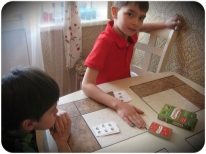How to develop a memory in a child of 7-8 years
As soon as the child goes to school, the parents inevitably face situations where the child becomes distracted, detached. And even if from the evening the whole family was taught poems set by the teacher, in the morning he can barely remember a few lines. In full growth, the family is faced with the question of how to improve the child’s memory and how to distinguish memory problems from other problems, mostly psychological, and banal laziness.
In this article we will explain how to check the memory of a child and how to help him improve it.
Age features
A new and unusual responsibility falls on your son or daughter with the start of school: before, everything was simple and clear, now they are demanding with the child both at school and at home. From this, most children fall into that very period, which is called a crisis of 7 years. They are afraid not to meet the expectations of their most dear people - their parents, and they are already beginning to fear ridicule from their peers. The nervous system suffers from constant nervous tension; children become forgetful and absent-minded. Temporary memory impairment at this age is a variant of the developmental rate.
But there are guys who study is easy and easy.
However, they also have “gaps” in their memory, but they are more likely connected with laziness to one degree or another. To understand why a child flies into one ear and flies out of the other, you need to carefully watch the child, talk to him more often, demand less and refuse any manifestations of categoricalness.
We carry out tests
You can check your ability to memorize, store and play information. To do this, there are several simple tests for memory:
- Test Luria. This method of research will show how well a memory of a child is developed, it is the most important element of the learning process. Conduct testing in a relaxed atmosphere, preferably in a quiet room, so that the child does not distract. Ask the child to sit back and try to remember the words. Call without unnecessary haste (with a pause of 2-3 seconds) ten words that the child knows well, but they should not be logically connected to each other. Example: cat, school, spoon, swing, forest, jam, car, sea, milk, elephant.
Ask the child to reproduce the words he remembered and mark on paper how many words and which ones he remembered immediately.
Then repeat the series of words and give a second attempt, it will give an opportunity to understand what words the child “fixed” in the head in the second place. Thank him and postpone the test for later. After an hour and a half, ask the child to remember which words you called, so it will become clear the state of ability to reproduce new information (deferred memorization).
If a child remembered 3-4 words at the first approach, this indicates a normal ability to memorize. In the second attempt, a child with a normal memory should reproduce at least 6-7 words. An hour later, the child must remember at least 6 words. With high memorizing abilities, the child after the second attempt can name from 8-10 words, and with low indicators - from 0 to 2.
- Test Smirnitskoy. This test will evaluate the state of visual memory, which is important for study. Put 10 pictures in front of the child with a variety of objects (ball, strawberries, balloon, etc.), give him two minutes to look closely at the whole row, and then ask him to turn away and remove 1-2 or even three cards.Ask the child to answer what is missing. If he succeeds at the first attempt, then everything is in order, but if even at the fifth attempt the child finds it difficult to say which cards are missing, this is a rather alarming sign.
- Test for checking long-term memory. For the study, you can use the same cards with images of objects familiar to the child. Put them in a row, and then show them one by one and call what is shown there. Then the cards are removed and the child is asked to list all 10 words that have been spoken. Then come back to this in an hour and a half and ask to remember what was depicted on the cards and what words you called. The result is evaluated as follows: normally, the child remembers up to 7 words when he first views and listens. After an hour and a half, he should remember at least 5-6 of them.
How to improve memory?
If the test results satisfy you a little, it's time to improve the memory and attention of your child. To do this, there are several simple "home" techniques that will help the child in a month and a half to memorize material easily and quickly, and reproduce through time with great accuracy.
Make it a rule every day to ask how his case.
Let him talk about his school day in the most detailed details, up to the color of the elastic on the hair of her neighbor on the desk. Read with him, often ask clarifying questions about the content of books. Record the child in the sports section, make sure that he walked enough and breathed fresh air.
Effective exercises and games
- "Journey to Africa." You can play this useful game in the evening, even at a family dinner or on the way to school. You start and say: "I went to Africa and saw an elephant there!" The child’s task is to repeat the name of your animal and add a new one (“I went to Africa and saw an elephant and a monkey there!”. You or a third family member should list the already named animals and add one from yourself (“I went to Africa and saw an elephant there, monkey and ostrich "). Well, if the length of the chain before the first error is 20-25 words.
- "Detective Sherlock Holmes." You can play this game while walking, on the road somewhere and even in your own kitchen. Name the object that is in the field of your square view (box for cereals). The child grabs the "baton" and calls the second square object in your kitchen (photo frame). Then it's your turn, and then - again the word to the child As soon as you take all the square objects in the room together, ask the child to close his eyes and hide one of them. The task of the child is to find the loss.
- "A big difference". Offer the child two identical pictures that are cast only slightly (such can be found on the Internet and printed). Ask him for the allotted time (for 5 minutes, for example) to find all the differences. Exercise is constantly complicated, the child is offered a more complex picture, and time for finding differences is given less and less.
- "What is it like?". The purpose of this exercise is to teach a child to memorize with associations. Give him an unfamiliar word, for example, “electorate”. Ask them to think what it can mean, let the son or daughter name all their associations, and only then, tell us what, in fact, are the people who are going to the polls. The more associations the child comes up with, the more likely that in 2-3 days he will tell the correct meaning of the compound word.
Tips
Do not force the child to engage developmental exercises by force - this will cause persistent rejection from the chad. It’s better if the child treats it like a game.
Make sure that the duration of classes does not exceed 15-20 minutes.
The younger students quickly get tired, and this should be taken into account.
Add foods containing Omega-3 and Omega-6 to the diet of the offspring; it has been proven that these substances improve memory. These products include walnuts, sea fish, chocolate, olive oil, fresh vegetables.
You will learn more about how to develop the memory of a child of 7-8 years old in the following video.





























